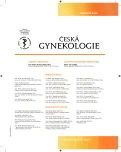Histological types of uterine fibroids in reproductive age and postmenopausal women
Authors:
J. Kadlecová 1; R. Hudeček 1; L. Mekiňová 1
; P. Ventruba 1; E. Jandáková 2
Authors place of work:
Gynekologicko-porodnická klinika LF MU a FN, Brno, přednosta prof. MUDr. P. Ventruba, DrSc., MBA
1; Ústav patologie LF MU a FN, Brno, přednosta doc. MUDr. L. Křen, Ph. D.
2
Published in the journal:
Ceska Gynekol 2015; 80(5): 360-364
Summary
Objective:
To review the incidence of histologic variants of uterine fibroids of patients in reproductive age and postmenopause. Analysis of potential relations between histological fibroids variants and hormonal activity of the patient.
Design:
Retrospective analysis.
Setting:
Department of Obstetrics and Gynecology, Masaryk University and University Hospital Brno.
Material and methods:
Retrospective analysis of 2,397 women who underwent myomectomy or hysterectomy at the Department of Obstetrics and Gynecology, Masaryk University and University Hospital Brno in years 2008–2014. According to input criteria – age of patients between 18–65 years, ultrasound confirmed uterine fibroid. Exclusion criteria was irregular menstrual cycle, hormonal therapy in history or hysterectomy performed for tumors of the small pelvis or for cancer of the uterus or cervix.
Group A consisted of 235 patients with regular menstrual cycles, between ages 18–40. Myomectomy was chosen for these patients.
Group B consisted of 433 postmenopausal patients between ages 50–65. Laparoscopic and abdominal hysterectomy was performed to these patients.
Results:
A statistically significant difference was observed in the occurrence of epithelioid type of leiomyoma between women age groups 18–40 and 50–65. In the group of postmenopausal women four malignant forms of leiomyoma were recorded, which were not statistically relevant.
Conclusion:
After evaluating statistical analysis it was found, that there is a statistically significant difference in epithelioid type of uterine leiomyoma. Four patients were detected malignant variant of leiomyoma – leiomyosarcoma in the group of postmenopausal women.
Keywords:
uterine fibroid, histological type, reproductive age, postmenopause
Zdroje
1. Bell, S., Kempson, RL., Hendrickson, MR. Problematic uterine smooth muscle neoplasms: a clinicopathologic study of 213 cases. Am J Surg Pathol, 1994, 18(6), p. 535–558.
2. Citterbart, K., et al. Gynekologie. Praha: Galén, 2001.
3. Crow, J., Gardner, RL., Mc Sweeney, G., et al. Morphological changes in uterine leiomyomas treated by GnRH agonist Goserelin. Int J Gynecol Pathol, 1995, 14(3), p. 235–242.
4. Kawaguchi, K., Fujii, S., Konishi, I., et al. Mitotic aktivity in uterine leiomyomas during the menstrual cycle. J Obstet Gynecol, 1989, 160(3), p. 637–641.
5. Kolařík, D., Halaška, M., Feyereisl, J. Repetitorium gynekologie. Praha: Maxdorf, 2008, s. 751–760.
6. Kurman, RJ. Blaustein's pathology of the female genital tract. fifth ed. New York: Springer-Verlag, 2002, p. 562–594.
7. Mára, M., Holub, Z., a kol. Děložní myomy – moderní diagnostika a léčba. Praha: Grada, 2009, s. 34–38.
8. Parker, WH. Etiology, symptomatology and diagnosis of uterine myomas. Fertil Steril, 2007, 87(4), p. 725–736.
9. Povýšil, C., Šteiner, I. Obecná patologie. 1. vyd. Praha: Galén, 2011.
10. Prayson, RA., Hart, WR. Mitotically active leiomyomas of the uterus. Am J Clin Pathol, 1992, 97(1), p. 14–20.
11. Robboy, SJ., Anderson, MC., Russel, P. Pathology of the female reproductive tract. Edinburg: Churchill Livingstone, 2002, p. 400–402.
12. Stewart, EA. Uterine fibroids. Lancet, 2001, p. 293–298.
13. Tavassoli, FA., Devilee, P. Pathology and Genetics of Tumours of the Breast and Female Genital Organs. Lyon: IARC Press, 2003, p. 233–242.
14. Velebil, P., Wingo, PA., Wilcox, LS. Rate of hospitalisation for gynecologic disorders among reproductive-age women in the United States. Obstet Gynecol, 1995, 86, p. 764–769.
15. Wilkinson, N., Rollason, TP. Recent advances in the pathology of smooth muscle tumours of the uterus. Histopathology, 2001, 39(4), p. 331–341.
Štítky
Dětská gynekologie Gynekologie a porodnictví Reprodukční medicínaČlánek vyšel v časopise
Česká gynekologie

2015 Číslo 5
- Horní limit denní dávky vitaminu D: Jaké množství je ještě bezpečné?
- Dlouhodobé užívání dienogestu v terapii endometriózy
- Moje zkušenosti s Magnosolvem podávaným pacientům jako profylaxe migrény a u pacientů s diagnostikovanou spazmofilní tetanií i při normomagnezémii - MUDr. Dana Pecharová, neurolog
- Isoprinosin je bezpečný a účinný v léčbě pacientů s akutní respirační virovou infekcí
- Postupné vysazování inhibitorů protonové pumpy
Nejčtenější v tomto čísle
- Psychické změny u žen v důsledku užívání hormonální antikoncepce
- Heterotopická gravidita po spontánní koncepci
- Histologické typy děložních myomů u pacientek v reprodukčním věku a postmenopauze
- Chirurgie bránice v léčbě pokročilého karcinomu ovaria
